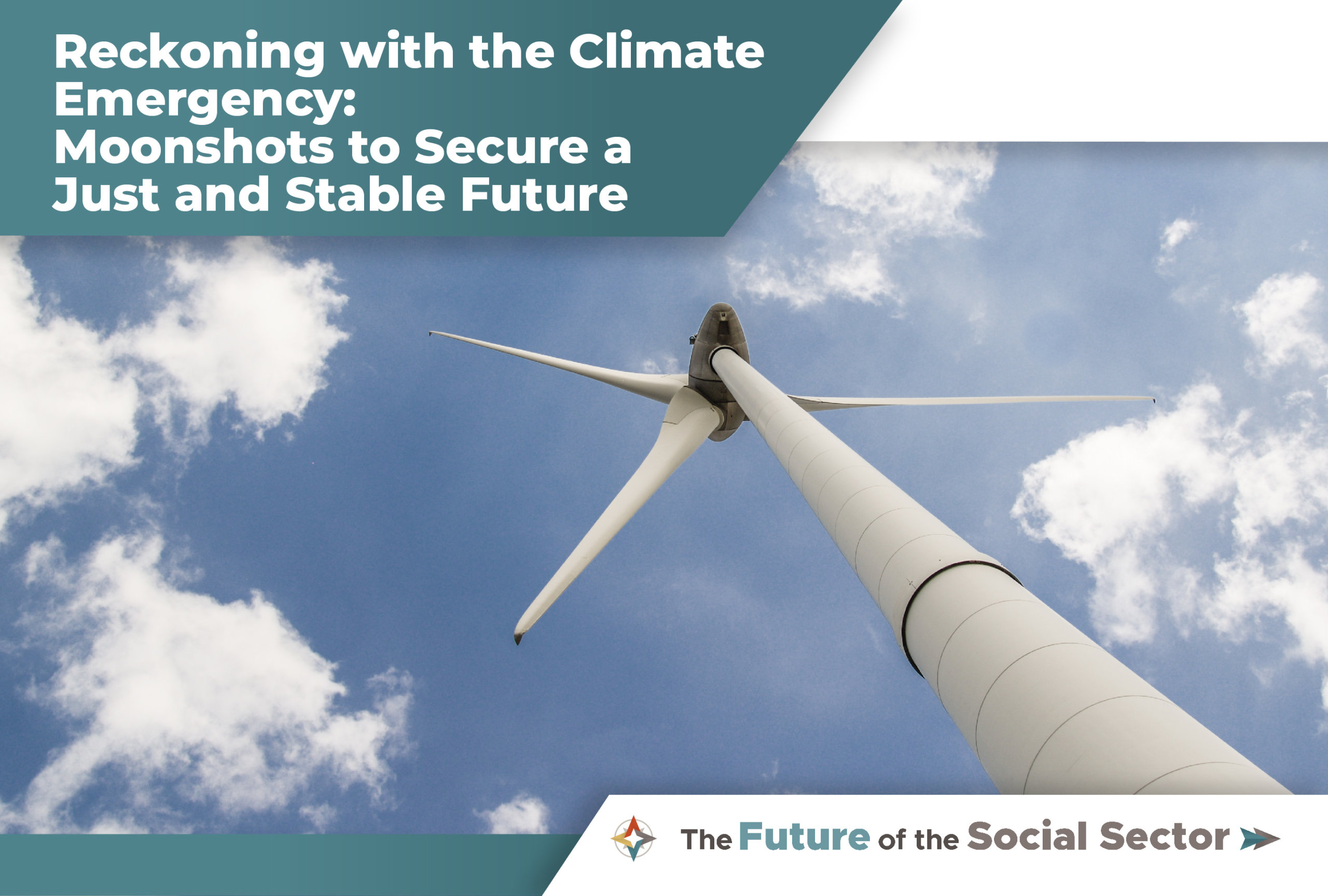Reckoning with the Climate Emergency: Moonshots to Secure a Just and Stable Future

Climate change threatens the very foundations of human civilization, and it may be the most existential crisis we face today. We are all bearing witness to climate change’s accelerating harms—the massive wildfires, storms, flooding, and heat waves increasing in frequency, intensity, and destructiveness. If we look more deeply, we can see that the climate crisis is intertwined with other crises as well. Climate change drives resource scarcities and migration crises that destabilize our political systems and fuel authoritarian movements. Conversely, political polarization and the delegitimization of government and scientific expertise damage our capacity for cooperative action on the scale we need to reckon with climate change.
As a social sector, what is our role in addressing this crisis? Are there tech-based moonshots that can help us rapidly reduce emissions and remove carbon from the atmosphere, and how can we support them? What are the potential unintended consequences of these new technologies? What kind of external conditions do they need to achieve impact?
In the latest webinar in Arabella’s Future of the Social Sector series, Principal and Senior Managing Director Bruce Boyd moderated a panel exploring these questions, featuring Danielle Deane-Ryan, director of equitable climate solutions at the Bezos Earth Fund; Sarah Kearney, executive director of Prime Coalition; and Michelle Martinez, director of the Tishman Center for Social Justice and the Environment at the University of Michigan. The thought-provoking discussion dug into how philanthropists can reduce the unintended consequences of new climate mitigation technologies and center the leadership, voices, and demands of those most directly harmed by the climate crisis.
The conversation was full of practical insight for philanthropists and impact investors, and we encourage you to view the recording if you weren’t able to join us. We’ve also gathered five main takeaways from the panel below.
1. Philanthropists must invest in building the resilience and power of communities most impacted by climate change.
As Michelle put it, “All people deserve a fighting chance to survive the climate crisis, but we are seeing huge disparities in communities’ ability to respond.” Communities of color disproportionately experience the physical, mental, and economic harms of climate change, but grassroots organizations led by people of color receive only 1.3 percent of all climate funding. This disinvestment is particularly damaging given the amount of money wielded by powerful players in the energy and agricultural sectors lobbying to promote projects that would harm these communities further. To level the playing field, the social sector must actively invest in organizations led by and working for communities of color.
2. The equitable approach to addressing climate change is also the most effective one.
“Getting resources to impacted communities and involving them in our climate work is a moral imperative,” said Danielle, “but it’s also a strategic necessity.” As Sarah pointed out, impacted communities and end users of climate mitigation technology have important knowledge and expertise that investors need to make good investment decisions. Omitting the lived experiences and knowledge of these on-the-ground communities is a surefire way to design and invest in solutions that don’t reflect what’s actually needed, and that are less impactful in mitigating climate change in the long run. Similarly, our solutions must consider both climate mitigation and climate adaptation, as under-resourced communities are already experiencing the negative consequences of our changing climate right now.
3. If we aren’t proactive, climate mitigation technology can have devastating unintended consequences, both human and environmental.
“Emissions reduction technologies have to operate at scale to be effective,” Sarah observed, “which means the unintended impacts on communities could be just as big.” With permitting and regulatory infrastructures failing to keep pace with climate mitigation technology’s rapid evolution, it’s imperative to consider a diverse range of impact metrics—not just those that come to mind first—before investing in a solution. Our risk-reward calculus must weigh the side effects on human and non-human life as heavily as profit, emissions reduction, or any other metric.
4. Philanthropy must support social movements and democratic infrastructure that will enable and steward climate technology.
When exploring and scaling new climate mitigation technologies and the conditions needed for their uptake, philanthropy has an essential role to play. As Bruce observed, “Philanthropists can be risk-takers in ways many other industries can’t.” Michelle called for “social technologies” that empower local communities to reimagine and reshape how they engage with energy and food systems while also giving them the ability to contest potentially damaging climate mitigation technology before it causes harm. And Danielle emphasized the importance of philanthropy investing in an enabling environment for climate mitigation technology, nurturing productive political conditions and safeguarding the democratic process in a way that enables the kind of large-scale systems change required to address the climate crisis.
5. Climate mitigation work must transcend polarization.
All panelists agreed that iterating on and implementing climate mitigation technology is an essential step to protecting our planet. However, increased political polarization, proliferation of disinformation, and a pervasive lack of trust in scientific experts all threaten the progress organizers have made toward climate resilience. Danielle emphasized that investing in communications strategies to counteract this trend is as important as building the technology itself. Michelle underlined the point: “I’m with Team Life on Earth. That should transcend every hard conversation you might need to have.”
You can hear more from our panelists, including their personal priority areas of investment for philanthropists and impact investors, by viewing the full recording. We hope you will join us for more conversations in the Future of the Social Sector series when we return in 2023 to continue discussing ways philanthropy can address our most entrenched social challenges.
